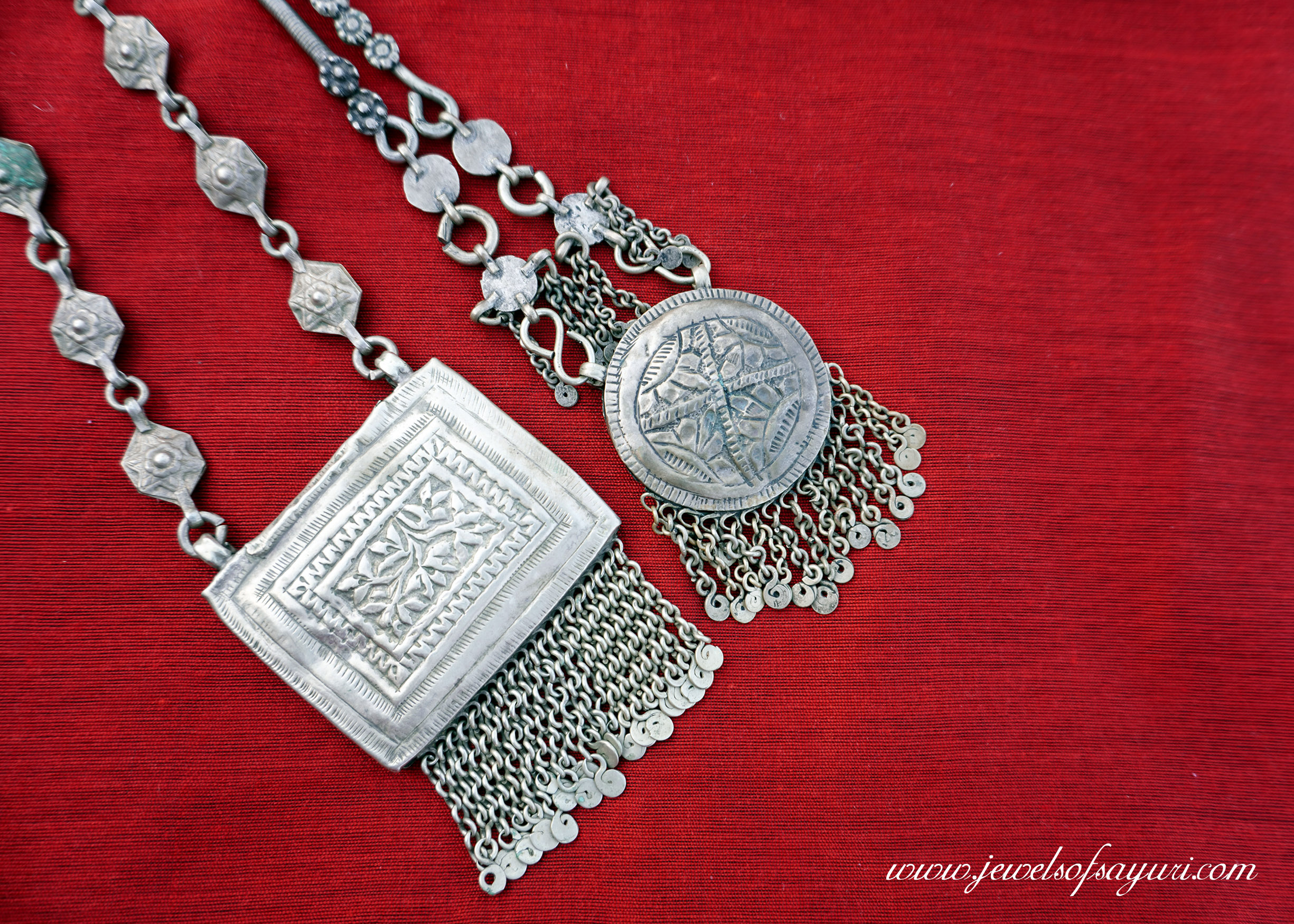During my recent solo travel in Kashmir, I went treasure hunting. I looked for places and people with whom I could find vintage jewellery. I did find a source in one of the most unassuming areas of Srinagar and it turned out to be one of the best days of my trip. Since then, I have been researching to understand the visual and material context of Kashmiri jewellery. However, I found very little information in books. Even those who are collecting or selling local jewellery seem to refer to the same object using different names, making it confusing. Therefore, I decided to create a Work in progress post to keep recording the various nuggets of information about traditional Kashmiri jewellery.

Classifications of Kashmiri jewellery
Kashmiri jewellery can be classified based on periods, geography, and material culture which is in turn region and social strata specific. If you refer to Indian texts that mention this region Pre-Islam then you will find Sankrit terms such as Haar (necklace), nupura (anklets), Kundala (earrings) which have disappeared from the vernacular. While there may be a continuation in the form of the object (motifs and materials would have changed), there are referred to in different ways with different words.
Jammu, Kashmir and Ladakh have very different cultural milieus, politics, follow different religions and traditions. Jammu is a predominantly Hindu region while Kashmir is predominantly Muslim. Therefore, the forms and motifs found in the jewellery of these regions and the way in which they are worn are different.
Then there is the general categorisation of Gold and Silver jewellery which is still (unfortunately) stuck in the colonial categorisation of fine and folk jewellery. Additionally, there is a third material, jewellery made of non-specific metal alloys in the hills and valley. This kind of jewellery is loosely referred to as mixed metal jewellery, molten pot metal or pot metal jewellery. They would have been made by melting different metals including silver in a crucible and then casting the alloy.
Traditional jewellery of Kashmir
Here is a consolidation of information found in the SPS Museum, Srinagar, the book Traditional jewelry of India by Oppi Untrachat, AsiaInch and information gathered from a client (a Kashmiri woman) who wishes to remain anonymous.
Head/Forehead ornament
- Jiggni – silver or gold round tikka with tiny bead/pearl hangings
- Dake Tikk – Forehead ornament/ maang tikka. Both Jiggni and Dake maybe engraved and set with coloured stones.
- Kasaba – ornamental cap (check the post on Dal Lake to see me wearing this cap)

Ornaments of the Ear
- Bala
- Dor-hor
- Alkhahor and attahor – These are ornaments worn at the ear but suspended and not from a piercing. These are pairs of jhumkas that are connected by chain and are worn pinned at the head. It could be covered by a cap or a veil.
- Jhumka – newer versions of the Alkhahor, where the drops are worn without the chain through a piercing in the ear lobe.
- Kanavaji/Kannavazey/ Kann-Vazi – Coiled metal rings tied together and suspended on cord. Worn at the ear.
- Kanador – gold earrings, teardrop shape, could have a bird like form on it
- Dejihoor – Gold earrings worn by a Kashmiri Pandit women after marriage. A Dejhoor is worn on the middle ear and has 3 components – a chain (Ath), a Hexagonal Pendant with 4 holes (Dejhoor) and a Small dangling pendant (Athoor). I once had a neighbour who wore the dejhoor with the chain being wrapped with red cord for a few days after her wedding.

Ornaments of the neck
- Halqaband/Alkavand – Large sectional necklaces where multi hole connectors are linked by thread. There is often a large pendant. Find one on my Instagram page JewelsofsayurInstagram page Jewelsofsayuri
- Kanthi – short necklace
- sagalar – heavy silver necklaces
- Dolemaal – necklaces with additional talismans
- Nalehaar – amulet style necklaces with hollow pendants and fringes.

Ornaments of the wrist
- Hangaar
- Gunus – Heavy metal cuffs with animal head terminals
- Dulu
- Bangri – bangles
- Bangaar- bangles set with colored stones

Traditional jewellery of Ladakh
- Skeypuk – necklace worn in the Sham Valley
- Sondas, branshil – marriage symbol fixed on the left shoulder and connected to silver or gold discs
- Perak – turquoise headress worn by Ladakhi women – 20-200 turquoise stones. It is embellished by a rectangular metal ornament with filigree, repousse and studded with stones.
- Chatelaine with brass or silver discs with the endless knot, 6-7 lines of cowrie shell with bells (Ghungroo) at the tips
- Gau box pendant – Shrine Amulet of silver set with turquoise and/or coral stones
Apart from the above, Ladakhi women as a part of their ethnic attire wear strands of beads of coral and turquoise, mother of pearl, pearls, amber, dzi and even glass.
Typical features of pot metal Kashmiri jewellery
- Chains with hollow embossed connectors in the shape of leaves, flowers, stars and mangos are often used along with pendants.
- Floral and foliate motifs prevalent across Kashmiri jewels
- Chain tassels and fringes
- The tassels or fringes end either with bells or flattened discs.
As I mentioned earlier, this is a WIP consolidation post of whatever little that I have learned in my search for Kashmiri Vintage jewellery. I apologise for any errors in interpretation and request experts to add to this post by sharing your knowledge about Kashmiri jewellery in the comments.
I hope you find it interesting
Cheers


What do you think?